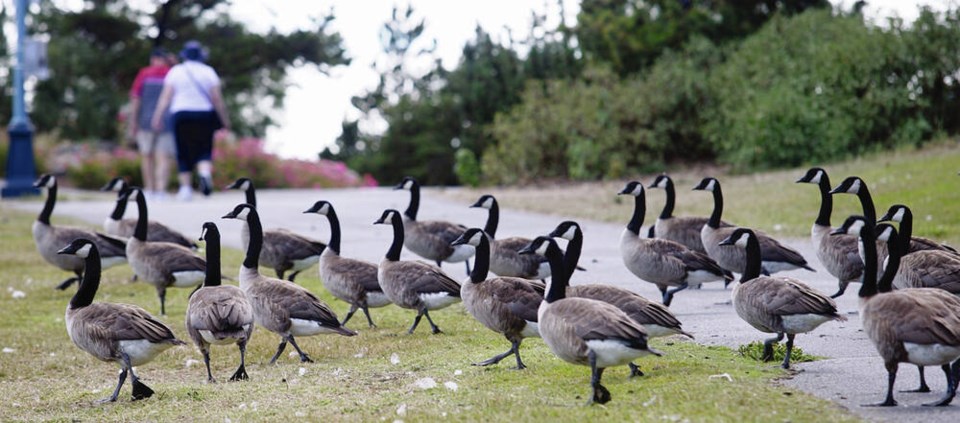With only 175 residents voting online to oppose a goose-management plan for the CRD, the regional government is a step closer to developing and putting a plan in place to control the region’s thriving Canada goose population.
Under the terms of the province’s Community Charter, at least 33,000 opponents — 10 per cent of eligible voters — had to vote against the plan to either send it back to the CRD board or trigger a referendum.
Details still have to be worked out, but the plan would likely include addling eggs and culling some of the adults.
The current 91原创 Island Canada goose population ranges from 10,000 to 15,000. An estimated 3,500 to 7,000 of the birds overwinter in our region, much to the chagrin of the area’s farmers, water-quality managers, health officers, greenskeepers, airport managers, swimmers, habitat managers and others.
Surveys from 2017 to 2021 indicate the population roughly doubles every 4.3 years.
The birds decimate crops. They foul playgrounds, schoolyards, soccer pitches, parks and beaches with their feces. They damage salmon habitat in tidal streams, harm wetlands and other sensitive ecosystems, and pollute lakes.
The population numbers are imprecise. We know from tracking banded birds that the geese move from region to region on the Island. New birds also arrive every year — much like tourists who visit and then trade in their Toronto or 91原创 or wherever lives for the Island’s lifestyle.
For that matter, the ancestors of the Island’s breeding permanent resident geese were introduced here. Only occasional pairs of the native subspecies, Branta canadensis fulva, breed on the Island.
The original subspecies doing the vast majority of eating, pooping and goose-begotten damage in these parts was introduced by government and private organizations to many areas in southern British Columbia, including 91原创 Island, with introduction efforts peaking during the late 1960s and the 1970s.
The result all these decades later is an overwintering breeding population on the south Island that is a hybrid of subspecies introduced from three different areas in North America’s interior.
As with Prairie and Ontario humans who now spend the cooler months here, the hardy hybrids find Victoria-area winters positively balmy. Why would they leave when the recent polar vortex that caused thermometers way out east to dip to -25 and -30 C bottomed our temperatures out at only -5 C?
And geese aren’t a new issue here either. Parks staff have been reporting on problems with geese since the late 1990s. An online search of these pages brings up articles, editorials and letters to the editor dating back more than 13 years.
Culls have taken place. In the CRD’s 2015 effort, 43 geese were killed for about $725 each.
A dozen activists protested the 2016 cull of nearly 500 Canada geese in Parksville.
Hunting, contraception, and dogs have been proposed as solutions. Coyote-shaped scarecrows (scaregeese?) were tested at area schools, with mixed results.
Duncan’s own Ron Stasynec proposed a remote-controlled, sled-like, loudly whining device, called the Goosinator, to deter the birds.
The takeaway? Canada geese are persistent. This, too, isn’t breaking news.
In what is merely the most recent study on Canada geese’s annoying intractability, University of Illinois researchers determined why most goose harassment tactics simply don’t work.
The researchers fitted Canada geese in Chicago with GPS transmitters with Fitbit-like movement trackers to learn where the geese go and how harassment changes their behaviour.
When the researchers harassed the geese, the birds did leave the area … but returned in about half the time they did on days when they weren’t harassed and left the park on their own.
Most harassed geese moved elsewhere in the same park or were back within the hour. Those that did leave went to commercial rooftops, railyards, other parks, water-treatment ponds, and sports fields — not exactly migrating long-distance and away from the urban area.
“The goal of harassment is never to hurt the geese, but to get them to use up energy during an already tough season, forcing them to migrate to warmer climates,” says the study’s lead researcher, Mike Ward. “Unfortunately, we found that doesn’t happen.”
“When they’re not being harassed, they’re making the choice to leave the park because it’s beneficial to them — there’s a resource elsewhere they want to access,” says co-author Ryan Askren. “Whereas when we’re harassing them, they probably have a biological reason to be there.
“There’s some sort of resource, such as food or water, and they want to be there at that moment. When we harass them, it causes them to leave momentarily, but more than likely they still have that drive to come back.”



